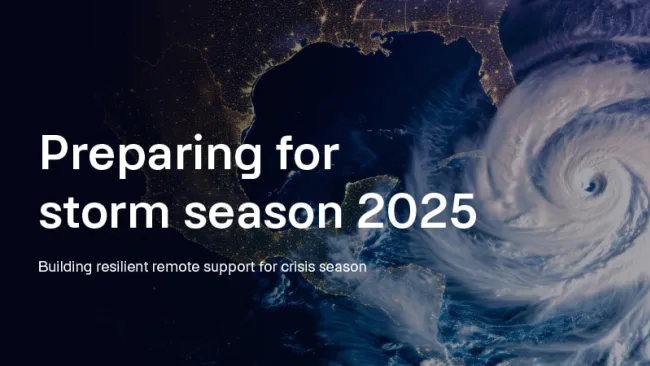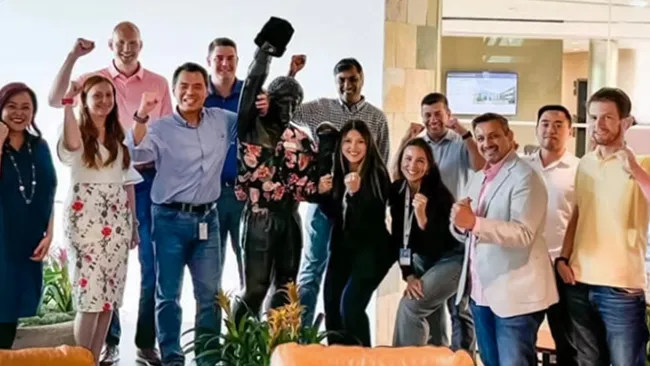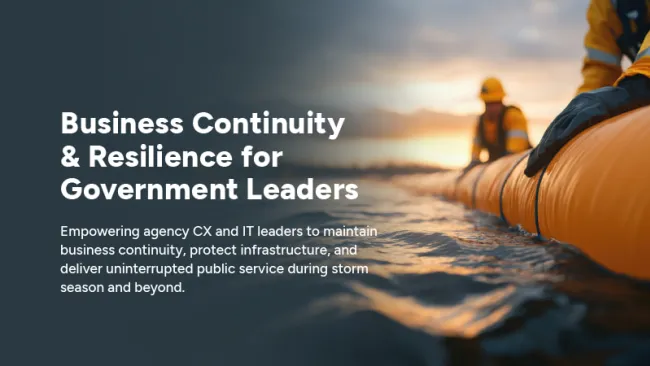The COVID-19 pandemic placed an incredible burden on government agencies. The need for information on unemployment, testing, and safety guidelines had call volume skyrocketing. Meanwhile, the rapid acceleration to remote work upended the norms in a traditionally brick-and-mortar environment. It was a back and forth battle to keep up with demand while trying to maintain a sense of normalcy.
To manage this crisis, agencies adapted to a new work-from-home environment that blended human and technological capabilities to manage the unprecedented volumes of calls. But the public sector is far from returning to normal, and will likely brace for more turbulent reactions to increasing unemployment and future COVID-19 concerns.
That’s why it’s so important to look back at the innovations that carried the government contact centers through crisis to consider how they can be deployed for future disasters.
Rapid work-from-home deployment
Citizens needed answers as soon as possible. Handling surge volumes required moving employees home and finding new talent. When this massive move took place, the recruiting and training had to, and must continue to meet the standards of a traditional brick-in-mortar center.
When deploying remote work, look to optimize all parts of the process, including:
Recruiting: Look for talent from all corners of the new work-from-home environment. The pool of potential candidates isn’t limited to geography or local travel restrictions, and recently displaced workers can leverage their expertise toward assisting fellow citizens.
Training: The typical classroom environment is gone. Curriculums need to be digital and digestible so employees can complete quickly at home whenever they can. For experienced employees moving home, deploy a shortened from-home curriculum to brush up on basics so they can resume work as soon as possible.
Activating: Follow security protocols to confirm agents’ devices are safe and use a secure VPN connection. Deploy performance management and QA tools to ensure agent productivity and effectiveness.
When the crisis began, many agencies surveyed employees to get a sense of their work-from-home capabilities. Finding out who has the best WIFI, available technology, and dedicated area for office space was paramount. Going forward, understand who is best suited for quick response and specialization to deploy agents to priority contacts and ensure the fastest and most effective interactions for the most critical citizen needs.
Don’t forget the human side. During both disasters and calm times, it is essential that extra steps are taken to help employees feel connected to their virtual coworkers and that they’re an integral part of a bigger mission. Day-to-day interactions and ensuring they feel valued are key.
Utilize technology to create a great citizen experience
Automated capabilities, such as bots and IVR, were able to quickly and significantly improve resolution and satisfaction for repeatable tasks while streamlining processes so human employees can focus on the tasks that need a human touch.
The increasing usage of digital channels will play a bigger role (e.g., in-app chat, SMS, web-based chat, social) down the road by allowing public-facing agencies to increase the number of people they can serve concurrently by 4X.
Messaging on mobile and social platforms is growing as an essential tool in communicating on the platforms that citizens use most. It’s an asynchronous and very conducive channel for the work-from-home environment since it takes up less bandwidth than voice and background noise isn’t an issue.
Ensure future operational excellence
Team leaders need to be incredibly focused on performance management while maintaining a human connection to their employees.
For the foreseeable future employees will not have in-person, face-to-face interaction with co-workers and supervisors. This can be replicated virtually by:
- Providing access to chat coaches and mentors: Recreate the traditional in-person environment by providing face-to-face conversations with your agents.
- Utilizing regular video coaching sessions: Remote workers cannot be limited to chat and messaging, allow them to use their voice.
- Performance management that matches physical centers: Utilizing the same in-house techniques holds agents to the same standards as brick-and-mortar agents.
- Engaging throughout the day via chat: Daily roundups and conversations create a sense of community for those separated.
- Offering employee community forums: Giving your agents a safe place to discuss their work conditions is key for connecting the workplace
- Generating virtual culture-building activities: No one should be left behind, include remote workers in the same bonding experiences you would give those in the center.
Make resiliency a part of your DNA
Preparing for the inevitable means understanding what went wrong and right during the pandemic. The government space during times of uncertainty needs to not only manage a body of concerned citizens but the people who assist with these very stressful and human interactions.
A forward-thinking mentality will be crucial down the road. The public sector may now be finer tuned to the changes that industries like retail and travel have always kept pace with. A focus on digitization, remote work, and flexibility will allow the sector to be better prepared for whatever comes next.















